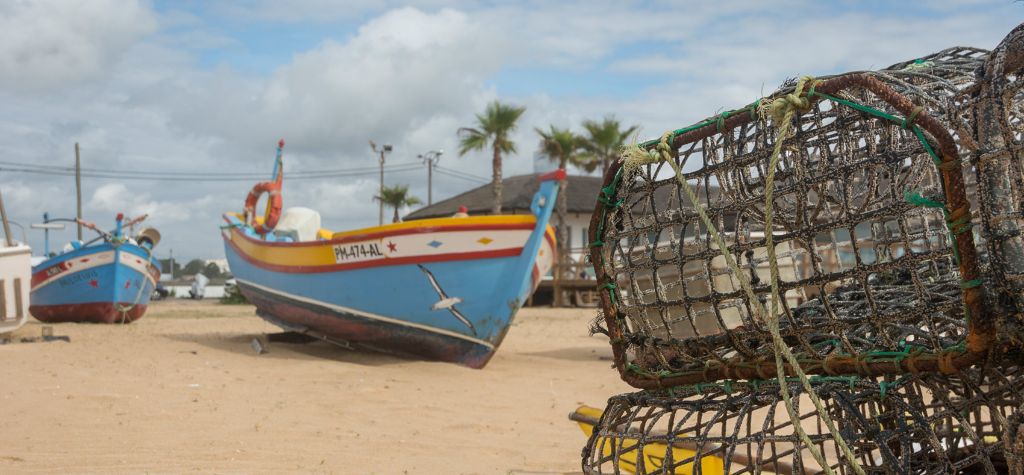Plenty of fish
Armação de Pera is a fishing village whose name came from the abundance of fish on its coasts, leading to the establishment of a tuna trap in the bay of Pera, 400 years ago.
The traps were deployed during tuna migrations, from April to August; they attracted not only fishermen but also the Maghreb pirates. This prompted the construction of Santo António Fortress, still a prominent building in the current landscape of the village. Historians know that these communities didn’t depend exclusively on tuna; in the 19th century and due to beach seine, sardine even became the main economic resource of Armação de Pera. By the middle of the last century, as tuna changed its migration routes, the traps were mainly catching sardine and mackerel and eventually they disappeared; today, from all those who worked on the traps, there are only a few people left. Tuna routes were replaced by other activities, and today Armação de Pera is a major tourist centre in the municipality of Silves, where fishing, the sea and fresh fish are parts of its brand.
In Armação de Pera, fishing operations start on the beach. Here, since immemorial times, boats were launched and stranded back again using nothing but “arms”. Over time, wood beams (parais) were deployed seawards and greased regularly, allowing boats to slide more easily. Nowadays, tractors replaced human force and assist the strenuous work of beaching (varar) fishing boats. This task was firstly done by private companies, but now the fishermen’s association has taken over.
Women have always played an essential role in the fishing activity; their tasks ranged from helping in beaching operations, handling nets and fish drying, to the recent leadership of the fishermen’s association.
In 2000, the village had registered 54 fishing boats and 73 seafarers. This was far above the current figures, with 15 boats and near 30 fishermen still working. This is the only fishing harbour of Silves municipality. There is one Docapesca fish market, managed in partnership with the local fishermen´s association. However, it only operates with cold storage, ice supply, first registration and weighing. The fish is then carried to the wholesale fish market in Portimão (or Quarteira) by the lorry of the fishermen’s association.
As in many other harbours of the Algarve, octopus pots are an emerging fishery. Even so, trammel and gill nets, in particular those targeting the red mullet, have an important role. Besides octopus, most of the catches are soles, red mullet, cuttlefish, sea bass and gilt-head bream. Despite its small activity, in this bay there is also a seafood targeted fishery, from April to December, when special pots are used to catch swim crabs. Beach seine and lift nets have continuously decayed. The elders repeat something you hear everywhere: “There was more fish back in the days than now”.
The fishermen’s association is very active and highlights all the achievements made at Praia dos Pescadores: the storage facilities, the sheds for fishing gears, the tractor for beaching operations and, of course, the co-management of the fish market and the transportation lorry. Direct sales to end-consumers and the “fish basket” are some of the possible future trends.
Gastronomy
From the rich and varied typical dishes of Armação, the main one is caldeirada, a fish stew prepared with toadfish, torpedo ray, skate, conger eel and other fish. Tradition says the best part of a caldeirada is the noodles soup prepared using the remaining broth of the stew. Bread stew (ensopado) with cuttlefish (or squid), or grilled fish were always on the table of this fishing community. However, octopus and especially fried moray eel (with olive oil and garlic) are the favoured snacks of the people of Armação de Pera
Festivities
In this village, religious celebrations are related to fisheries: the feast of Nossa Senhora dos Navegantes (Our Lady of the Navigators), on the second Sunday of August, and the feast of Nossa Senhora dos Aflitos (Our Lady of the Distressed), on the third Sunday of September.
Must-Visit
Fortress and Santo António Chapel, Caldas and Vasconcelos Palace, the building of the former CasinoRua dos Abraços (a street in the old village, commonly known as aldeia; or “the village”), traditional boats, Praia dos Pescadores (the fishermen’s beach is the only private beach in Portugal), sand dunes, limestone cliffs (and its caves and stacks), Lagoa dos Salgados, the Interpretation Route of Praia Grande (AT, Algarve Tourism), scuba diving at “Poço“


